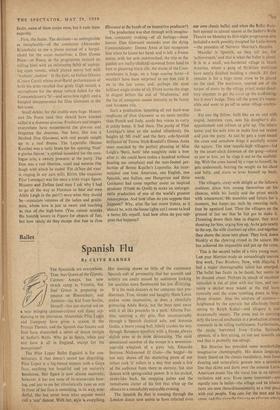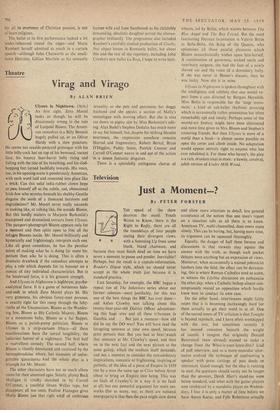Ballet
Spanish Flu
By CLIVE BARNES The Pilar Lopez Ballet Espafiol is for con- noisseurs, if that doesn't sound too dispiriting. Pilar Lopez is a big-boned woman with a Goya face, anything but beautiful and yet maturely handsome. Her figure is now almost matronly; however, it has lost none of its aristocratic bear- ing, and just to see her ritualistically raise an arm in front of her face is something, in its way, won- derful. She has never been what anyone would call a 'star' dancer. With her, style is everything. Her dancing shows so little of the customary Spanish cult of personality that her warmth and artistry arc easily missed by audiences looking for qualities more flamboyant but less satisfying.
It is the male dancers in her company that pre- dominate. True, slender and haughty Nana Lorca makes some impression, as does a cheerfully grimacing Adcla Borja, but the boys strut away with it all like peacocks in a park. Alberto Por- tillo, sporting a shy grin, flies unconcernedly through a Spanish classical solo, and Antonio Gades, a brave young bull, lithely crashes his way through flamenco numbers with a, finesse, always stylish even at its Most devastating. The most sensational member of the troupe is a seventeen- year-old whiplash of, a gipsy boy, Eduardo Serrano. Nicknamed E/ Guito—the beggar—he not only shows off the shattering pouts of our infant rock 'n' rollers in a way that sends a few of the audience from there to eternity, but also dances with spring-coiled power. It is his arched, snake-like back, his snapping palms and the tumultuous clatter of his feet that whip up the climax to a remarkably enjoyable evening.
The. Spanish flu that is running through the London dance now seems to have infected even our own classic ballet, and when the Ballet Ram- bert opened its annual season at the Sadler's Wells Theatre on Monday its first-night programme also included a work possibly designed for Latin-lovers —the premiere of Norman Morrice's Hazafia.
'Hazafia' is Spanish, so they tell me, for 'achievement,' and that is what the ballet is about. It is in a small, sun-hardened village in South America, where a gang of 1l-bitten workmen have nearly finished building a church. All that remains is for a huge stone cross to be placed on the roof. The workmen, spurred out of the torpor of siesta by the village priest, make desul- tory attempts to get the crc3s up the scaffolding, but it won't budge. They tell the priest it's impos- sible and want to go off to some village celebra- tion.
Yet one big fellow, built like an ox and with stupid, lustreless eyes, sees his daughter's dis- appointment and refuses to give up. The others leave, and his wife tries to make him see reason and join the party. At last he gets a rope round the cross and somehow drags it painfully across the square. The now tequila-high villagers—led by the smart-aleck foreman of the gang—return' to jeer at him, yet he slogs it out to the scaffold- ing. With the cross bound by a rope to himself, he gets underneath, bearing the weight on his chest and belly, and starts to lever himself up back- wards.
The villagers, crazy with delight at the fellow's madness, place bets among themselves on his chances, while his family and the priest watch with amazement. He stumbles and falters for a moment, but keeps on, inch by sweating inch, foot by agonised foot. Then the villagers on the ground at last see that he has got to make it. Throwing down their bets in disgust, they start shouting for him, urging him up. As he gets nearly to the top, the wife clambers up after, and together they shove the cross into place. They look down blankly at the cheering crowd in the square. He has achieved the impossible and put up the cross.
This is the second ballet of a very young man. Last year Morrice made an astonishingly mature first work, Two Brothers. Now, with Ilazaha, I feel a Major choreographic talent has emerged. The ballet has faults to be faced, but merits to be shouted about. Perhaps its smack of excelsior optimisin is out of joint with our time, and cer- tainly a .slicker man would at the end have cynically sent the cross tumbling down to Sisy- phean disaster. Also the mixture of verismo-- heightened by the operatic but effectively literal setting by Ralph Koltai—and allegory is just occasionally uneasy. The cross and its carrying defy the laws of mechanics in a production almost cinematic in its telling truthfulness. Furthermore, the muSic, borrowed from Carlos Surinach appears, at a first seeing, to run out towards an end that is probably too abrupt.
But Morrice has provided some wonderfully imaginative choreography. His dance language, freely based on the classic vocabulary, here fuses dancing and naturalistic gesture into a seamless line that skims and darts over the sinuous Latin- American music like the vocal line in an opera'5. recitative and aria. Even more important—and equally rare in ballet--the village and its inhabi. tants are seen three-dimensionally as a real piaci with real people. You care for the man and hit cross, and this oiv,-c tha enre- to In n11^^"r•' for all its overtones of Christian passion, is not at heart religious.
The ballet at its first performance looked a bit under-rehearsed round the edges—and Marie Rambert herself admitted as much in a curtain speech—although John Chesworth as the small- town Hercules, Gillian Martlew as his sensually human wife and June Sandbrook as his childishly demanding, idealistic daughter served the choreo- grapher brilliantly. The programme also included Rambert's carefully studied production of Giselle, that object lesson in Romantic ballet, but about this and the rest of the repertory, including John Cranko's new ballet La Reja, I hope to write later.















































 Previous page
Previous page